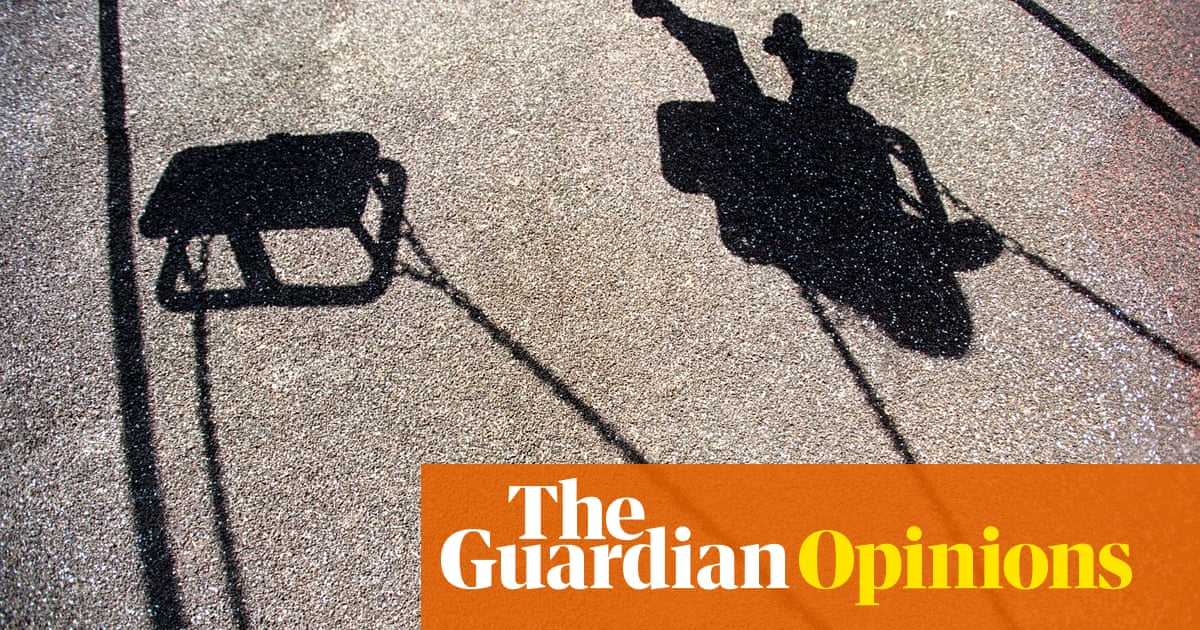
Charlotte Hooper was in a university lecture when the Facebook message flashed up on her phone. She shot a quick glance at it – there were 10 minutes of class left – and brushed it off. It was from an acquaintance: “Is this you?”, he asked, attaching a link. She assumed it was some kind of scam.
But within seconds, another notification popped up: this time, screenshots of selfies she had taken over the years. “I had a very physical reaction to it – my whole body tensed up. I thought: oh shit, yeah, this is me.”
She followed the link to find that photos of her, taken from age 16 onwards, were being hosted on an X-rated chat forum. The pictures were just “totally normal selfies”, she explains, not intimate images. “One is with a full face of glam makeup on … In another, I’m wearing my Primark uniform.”
They had been posted on Reddit forums with names like “r/IWantToFuckHer” by an account that had shared them “with really sexual comments”. In one, the poster asked others to rate her out of 10; in another, they asked men to ejaculate on her image and send them a picture. The same user had been posting pictures of various other “girls from the alternative subculture” on subreddits, and those pictures were then reposted on other even more explicitly pornographic websites.
“It felt really surreal, like I was in a fever dream,” says Hooper. “I was panicking.”
It was mid-October 2019, and 20-year-old Hooper, from Essex, was in her second year of a policing and criminal justice degree. As class wrapped up, she told the lecturer what had happened. Within the hour, while she waited for her train, Hooper had submitted a 101 police report online.
But as she made her way home, there was something else spinning through the “whirlwind” in her mind. The acquaintance who had warned her she was being targeted thought he knew who was behind it, because his girlfriend, another victim, had pieced it together. “This is the guy we think is doing it,” he said, sending a screenshot of a Facebook profile.
Looking at the profile picture, Hooper felt a stab of familiarity: the account belonged to someone she had never met, but who had messaged her, on and off, for more than five years. His profile showed he lived in a town 20 minutes away.
Hooper was 12 when she signed up for Twitter in 2011. “No one I knew had it – that was the beauty of it,” she remembers. “I hated school, I had undiagnosed autism and I was being bullied. I was in therapy and on antidepressants. Twitter was an escape.”
As Hooper entered her teens, her life revolved around music; specifically, pop-punk bands like My Chemical Romance and All Time Low. She embraced the alternative style (she dyed her hair “pink, blue, green – every colour you can name at some point”), and took to social media. “I wanted to find a space where people liked the same thing as me,” she says. “In the least cringe way, it gave me an outlet.”
By 16, she had amassed 20,000 Twitter followers and was active in fandom circles on Tumblr, Facebook, Snapchat and Instagram. “My mum used to come with me to concerts and there’d be people who recognised me from this online fandom,” she remembers. “She thought it was weird.” But Hooper didn’t feel she needed to fill her in too much. “I didn’t think I was at risk … and I don’t think she’d have known what to do about it, either.”
And anyway, Hooper, who was being home educated by 13, was enjoying having a rich online social life. “I had lots of online friends and built up a following in fandom circles. Many were a bit older.” Some were a lot older: Hooper remembers that among her online followers were men in their 50s and 60s. “I’d notice people pop up and think – why are you following me? What have we got in common? I just wouldn’t follow them back.”
Messages from strangers began to pile up in her inbox. “At the peak, there might be 30 to 40 a day, [many] of them sexual, from men in their 20s to 60s. I was very open about my age on my profile – I was clearly under 18.” Sometimes she would block accounts, but more often, she’d ignore them.
Ryan (not his real name) was one of her more persistent followers. “I’d say he was about five years older,” she reckons. “The messages were all like: ‘Hi. Hello. How are you doing? Wish we could talk.’” To Hooper, he just seemed like “someone who wanted to talk to me, that I wasn’t really interested in”.
His DMs might stop for a few months, and then start again, continuing daily. “What was weird was how he jumped between platforms – he’d find me on Facebook, then move to Tumblr.” Hooper responded once, in 2013. Then, for the next five years, she ignored him. Despite the frequency of his messages, he didn’t particularly stand out – Hooper got a lot of DMs, some of them daily. Did she see the messages as the price of having a life online? “Definitely. I thought: I’ve put myself out there … and the content of his messages didn’t seem malicious. It felt like a cost of being on social media.”
But by the time Hooper was at university, her internet presence was declining. “I’d say between the ages of 18 and 20, I lost about half my followers,” she says. “That was always really weird to me … The content I posted didn’t change.” By the time she got that fateful Facebook message in October 2019, she was already spending less time online.
The police response was dispiriting. She says she was repeatedly passed between two forces and in the end the officer sent to take her statement “clearly had no clue about tech – or how to handle a young girl’s experience”.
“It was retraumatising,” Hooper remembers. “I was left to explain what Reddit was to the officer … I’m sat there thinking, does he know what he’s doing?” She remembers having to define the misogynistic terms used to describe her: “What ‘DSL’ stands for, ‘dick sucking lips’. It felt really embarrassing for me.”
What support was she offered? “Nothing. What was interesting was a year or two later, somebody knocked the wing mirror off my car. And as soon as I reported it, I had a text saying: do you need help with victim support? And I was like, not really … But that would have been great a year ago!”
In February 2020, the police confirmed that it was Ryan who had been posting her pictures. He admitted it to the police and was cautioned under the Malicious Communications Act. Her case was closed.
However, Hooper found she couldn’t stop looking over her shoulder. “Knowing how close he was … that was the worst part,” she says. Earlier that year, she had started volunteering with the Cyber Helpline, a charity advocating for cybercrime victims, where she is now operations manager. The charity works with victims of digital fraud and scams, as well as online harassment, grooming and intimate image abuse. It also supports stalking victims, 80% of whom are women; cyberstalking, along with online harassment, accounts for more than 30% of all cybercrime cases reported at the Cyber Helpline. Up to 700,000 women in the UK are believed to become victims of stalking each year – but research by the Suzy Lamplugh Trust, which runs the National Stalking Helpline, indicates that only 1.7% of stalking reports end in a conviction.
After the police cautioned Ryan, Hooper knew there was a chance the stalking could intensify. “I’m thinking: is he going to escalate now I’ve reported him? I was on very high alert – I didn’t know what he was capable of.” Was he angered by the police caution, she wondered. Could he be watching her in person, too?
She had been unable to sleep in the days after finding her photos online, and months on, she could still feel alarm bells ringing, a state known as hypervigilance. “Whenever I left the house, I thought: is he going to be there? The scariest part was not knowing what his next step was going to be.”
Hooper had grown up regularly visiting the town where Ryan lived, but she has not been able to face going there since. She shut herself away from socialising for a while and was terrified he would walk into the shop where she worked. The fear would twist her thoughts: if her phone was acting up, she would catch herself wondering if he had hacked it. “Or I’d see people in public, and wonder – have they seen the posts?”
She would be set on edge by simple things, such as being added to a WhatsApp group chat, in case it led to Ryan finding her number. “Any information leakage was the end of the world for me,” she says. “I knew my data was out there, and I just wanted to suck it back in.”
Ryan had deleted his social media profiles since being called out online by another victim, and Hooper knew little about him. But she seemed to see pieces of him everywhere. If a man in the street had the same colour hair, she’d stare at the back of his head until he turned around. Thankfully, it was never Ryan – though she is not sure she would have recognised him, based only on one profile picture taken years ago: “I felt like he could see me, but I couldn’t see him.”
Despite her expert knowledge of the subject, it took Hooper years before she called what was happening by its name. “At the time, I’d never have said this was stalking,” she says. She questioned whether it was “bad enough” to count. But now, as she lays out the hallmarks of stalking behaviour – “fixated, obsessed, unwanted, repeated” – she wishes that at the time Ryan was cautioned she had pushed for stalking and harassment charges. “And this is just what I know about. I don’t know if anything else was going on.”
Although at first she tried to rationalise away what had happened, the way the pictures had been used hit home. “I felt objectified, like I’d been used as a fetish, which made it feel a lot more personal.” Although Ryan deleted the posts, some remain archived on porn sites, which she says have not responded to her requests for them to be taken down.
Still, Hooper feels “pretty lucky” that deepfake technology was still nascent at the time. “We’ve seen a lot of people come to the helpline with really similar [experiences],” she says – but additionally, the perpetrator has used deepfake “denuding” technology, either out of “pure maliciousness” or to extort money.
Though Ryan never contacted her again after his police caution, it took time for the feeling of threat to dissipate, Hooper says. “But every time I look over my shoulder and he’s not there, I become a little less hypervigilant.”
In the days after October 2019, Hooper made her Twitter and Instagram feeds private. But then she decided she wasn’t going to back down. “It was quite hard, because I felt like I wanted to. But for me it was just: I don’t want to change anything because of this person. The onus should be on him, not on me.”
Though Hooper had planned to go into policing, her experience drove her to focus on cybercrime victims, and she recently led the Cyber Helpline’s launch in the US. “My work has been a major part of coming to terms with it,” she says. “Putting my energy into supporting others has been therapeutic.” The charity works with stalking charities and trains police officers: “Multi-agency collaboration is really key.” Last year, Hooper was given a Diana award and a Crime Fighters award for her work.
It also expanded the scope of her ambition. “Before my experience, my motivation was: how can I support individuals to get the justice they need? My perception has changed in what needs to be [done] as a whole. Cybercrime makes up half of all crime but only 5% of police resources are allocated to it. There’s a clear need to change how we tackle the problem.” With a staggering 87% of cybercrime cases in the UK resulting in no action, she feels there are “major opportunities for developing how victims are treated … whether that’s a national cyber force” or specialised officers within forces.
Tech companies, too, must take responsibility and make cyber safety experts central, she says. “You wouldn’t release a car without putting it through rigorous safety testing. AirTags were a good example – only after they’d been used for malicious purposes did they implement safety features.
“At the moment, the onus is on the victim. And many platforms are doing the opposite of what they should be doing,” she says, pointing to X relaxing its blocking function while it and other platforms automate their trust and safety teams.
This kind of cybercrime transcends borders, and Hooper is backing moves for international efforts to tackle it. Five years on from that “surreal” day in the lecture theatre, she says: “It’s left me with a real drive to change how we perceive cybercrime – and how people get justice.”
In the UK, the National Stalking Helpline is on 0808 802 0300 or email via its inquiry form. In the US, resources are available at stalkingawareness.org.












